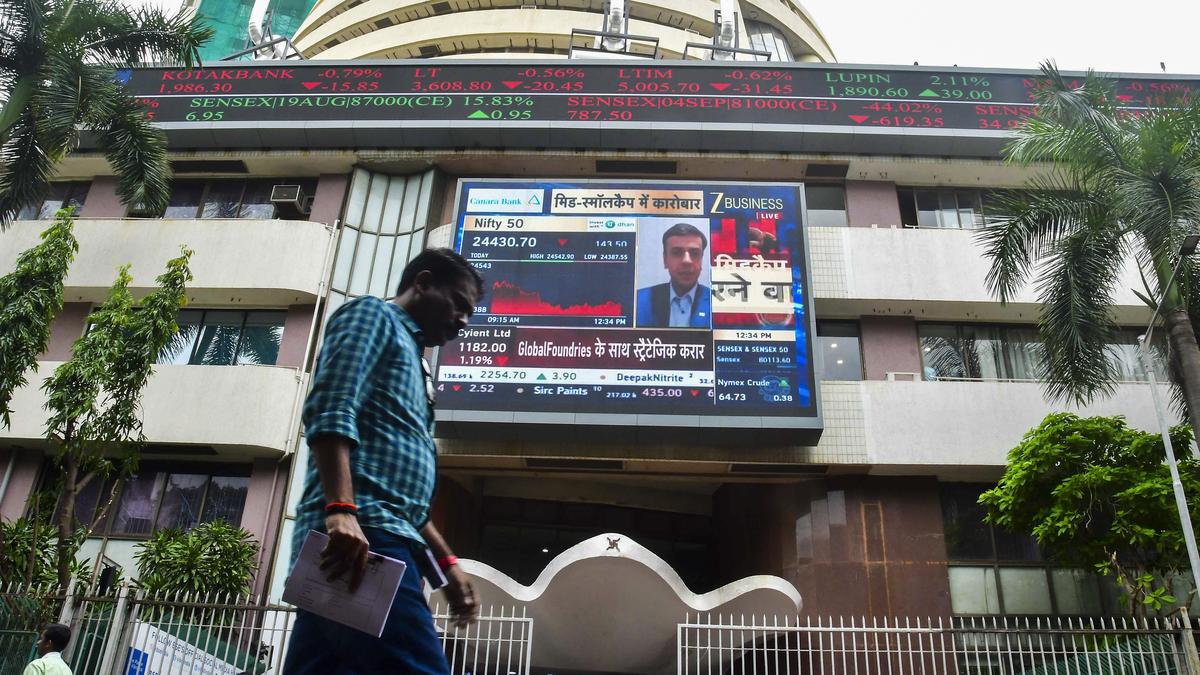- April 4, 2025
Global markets, Wall Street continue to slide after China retaliates tariffs on US imports after Trump’s move
Electronic boards show Shanghai stock and other market indices in Shanghai, China April 3, 2025.
| Photo Credit: Reuters
Global markets slid further and Wall Street was on track for another day of crushing losses Friday (April 4, 2025) after China responded to U.S. President Donald Trump’s latest set of tariffs with some of their own.
The S&P 500 lost 6% after China matched President Donald Trump’s big raise in tariffs announced earlier this week. The move increased the stakes in a trade war that could end with a recession that hurts everyone. Not even a better-than-expected report on the U.S. job market, which is usually the economic highlight of each month, was enough to stop the slide.
The drop closed the worst week for the S&P 500 since March 2020, when the pandemic ripped through the global economy. The Dow Jones Industrial Average plunged 2,231 points, or 5.5% and the Nasdaq composite tumbled 5.8% to pull more than 20% below its record set in December.

That follows Thursday’s (April 3, 2025) losses for the three major U.S. indices, which ranged between 4% and 6%. Thursday’s (April 3, 2025) wipeout was Wall Street’s worst day in five years.
Markets in Europe were having an even rougher time on Friday (April 4, 2025). By midday, Germany’s DAX had lost 5%, the CAC 40 in Paris slipped 4.2% and Britain’s FTSE 100 gave up 3.8%.
Oil prices fell as much as 8%.
China announced early Friday (April 4, 2025) that it will impose a 34% tariff on imports of all U.S. products beginning April 10, part of a flurry of retaliatory measures following Mr. Trump’s “Liberation Day” slate of double-digit tariffs.
The new tariff matches the rate of the U.S. “reciprocal” tariff of 34% on Chinese exports Mr. Trump ordered this week.
The U.S. exports an array of goods to China, including machinery, soy, corn and aerospace products. Shares in companies that stand to suffer from China’s tariffs include Deere & Co., which fell 4.7% in premarket; and Boeing, which slid 6%.
Apple saw its shares decline 4.7%.
The Commerce Ministry in Beijing also said that it will impose more export controls on rare earths, which are materials used in high-tech products such as computer chips and electric vehicle batteries.
The Chinese government is also subjecting 27 additional U.S. companies to trade sanctions or export controls and filed a lawsuit with the World Trade Organization over the tariffs.
Everything from crude oil to Big Tech stocks to the value of the U.S. dollar against other currencies has fallen since Mr. Trump’s tariff announcement Wednesday (April 2, 2025) afternoon. Even gold, a traditional safe haven that recently hit record highs, pulled lower.
Mr. Trump announced a minimum tariff of 10% on global imports, with the tax rate running much higher on products from certain countries like China and those from the European Union. Smaller, poorer countries in Asia were slapped with tariffs as high as 49%.
Economists say the tariffs increases the risk of a potentially toxic mix of weakening economic growth and higher inflation.
It’s “plausible” the tariffs altogether, which would rival levels unseen in more than a century, could knock down U.S. economic growth by 2 percentage points this year and raise inflation close to 5%, according to UBS.
Later Friday (April 4, 2025) the U.S. government offers up its March jobs report.

Yields on Treasurys tumbled in part on rising expectations for coming cuts to rates, along with general fear about the health of the U.S. economy. The yield on the 10-year Treasury fell to 3.89% from 4.01% late Thursday (April 3, 2025) and from roughly 4.80% in January. The last time it had fallen below 4% was in October.
U.S. benchmark crude oil shed $5.32 to $61.63 a barrel, its lowest level since mid-2021. Brent crude, the international standard, was down $5.26 at $64.88 a barrel.
Shares of Exxon Mobil slid 4.2% and Chevron fell an even 4%.
Markets in Shanghai, Taiwan, Hong Kong and Indonesia were closed for holidays, limiting the scope of Friday’s (April 4, 2025) sell-offs in Asia.
Tokyo’s Nikkei 225 lost 2.8% to 33,780.58, while South Korea’s Kospi sank 0.9% to 2,465.42.
The two U.S. allies said they were focused on negotiating lower tariffs with Mr. Trump’s administration.
Australia’s S&P/ASX 200 dropped 2.4%, closing at 7,667.80.
In other trading early Friday (April 4, 2025), the U.S. dollar fell to 144.89 Japanese yen from 146.06. The yen is often used as a refuge in uncertain times, while Mr. Trump’s policies are meant in part to weaken the dollar to make goods made in the U.S. more price competitive overseas. The euro rose to $1.1074 from $1.1055.
Published – April 04, 2025 06:12 pm IST







